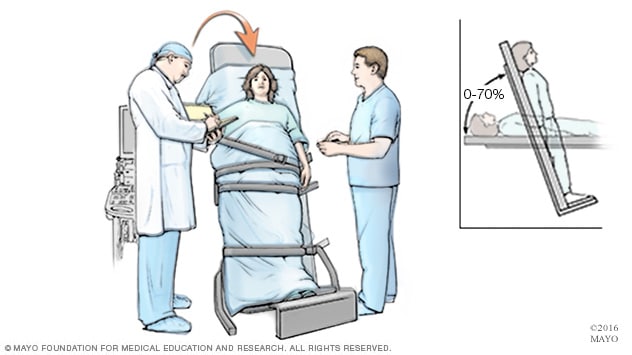Overview
Tilt table test

Tilt table test
A tilt table test shows how the heart and nervous system respond to changes in position. Someone having a tilt table test begins by lying flat on a table. Straps hold the person in place. After a while, the table is tilted to a position similar to standing.
A tilt table test shows how the body reacts to changes in position. It can help find the cause of fainting or dizziness. The test is often used when fainting happens for no known reason.
Products & Services
Why it's done
A tilt table test may be done if you faint with no known cause. Fainting may be a symptom of some heart or nervous system conditions such as:
- Orthostatic hypotension.
- Postural orthostatic tachycardia syndrome (POTS).
- Irregular heartbeats, called arrhythmias.
Other symptoms of these conditions may include dizziness and lightheadedness.
More Information
Risks
A tilt table test is generally safe. Complications are rare. But, as with any medical procedure, the test does carry some risk.
Potential risks of a tilt table test include:
- Low blood pressure.
- Weakness.
- Dizziness or unsteadiness.
These risks can last for several hours. But they usually go away when the table returns to a flat position.
How you prepare
You might be told not to eat or drink for two hours or more before a tilt table test. You can take your medicines as usual unless your healthcare team tells you otherwise.
What you can expect
Before
Before a tilt table test starts, you lie flat on a table that has a footboard. Straps go across your body to hold you in place.
Sticky patches called electrodes attach to your chest, and sometimes your legs and arms. Wires connect the patches to a machine that checks your heartbeat.
A cuff placed on your arm or wrist checks your blood pressure. A device on your fingertip checks your oxygen level. Sometimes, a needle is placed in a vein in the arm if medicines are needed during the test.
During
During a tilt table test, a healthcare professional watches to see how changes in position affect your heartbeat.
- You lie flat on a table for about five minutes. A member of your care team watches your heartbeat and blood pressure. The table is then tilted to a position that mimics standing. Depending on the reason for the test, you may stay in this position from 5 to 45 minutes. Your care team member continues to watch for any changes in your heartbeat or blood pressure.
- While in this position, stay as still as possible. Tell your healthcare professional if you feel sweaty, lightheaded or dizzy, sick to your stomach, or if you have a pounding, racing heartbeat.
- If you don't faint or have other symptoms after 45 minutes, you may get a medicine that triggers the nervous system response that causes you to faint. This medicine is given through a needle in a vein in your arm.
- You then stay standing strapped to the table for another 15 to 20 minutes.
The nervous system controls the body's heart rate and blood pressure. When you move to an upright position during a tilt table test, your heart rate and blood pressure may suddenly lower for a short time. As a result, less blood flows to the brain, possibly causing fainting.
After
If you faint during the test, the healthcare professional puts the table back to a flat position right away and carefully checks you. Most people who faint during the test regain consciousness almost immediately.
When the test is complete, you can return to your regular activities.
Results
The results of a tilt table test are based on whether you faint during the test. The results also depend on what happens to your blood pressure and heart rate.
- Positive result. Blood pressure drops and heart rate changes, causing dizziness or fainting during the test.
- Negative result. Heart rate increases only slightly. Blood pressure doesn't drop significantly, and there are no symptoms of fainting.
Depending on the results, your healthcare professional might recommend more tests to look for other causes of fainting.